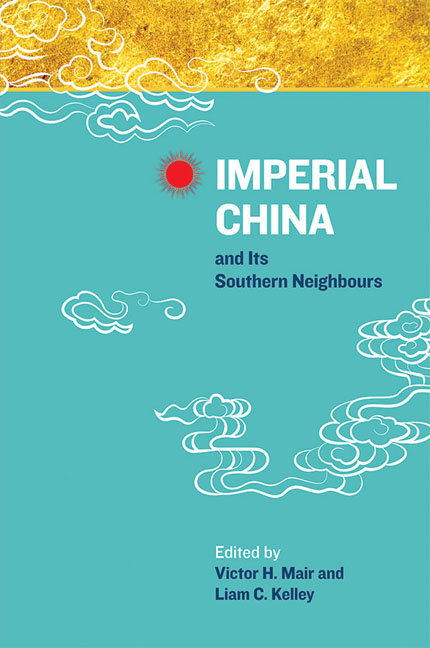Book contents
- Frontmatter
- Contents
- Preface
- The Contributors
- 1 Introduction: Imperial China Looking South
- 2 Layers of Meaning: Hairstyle and Yue Identity in Ancient Chinese Texts
- 3 Sinicization and Barbarization: Ancient State Formation at the Southern Edge of Sinitic Civilization
- 4 Clothes Make the Man: Body Culture and Ethnic Boundaries on the Lingnan Frontier in the Southern Song
- 5 What Makes a Chinese God? or, What Makes a God Chinese?
- 6 Dragon Boats and Serpent Prows: Naval Warfare and the Political Culture of China's Southern Borderlands
- 7 Inventing Traditions in Fifteenth-century Vietnam
- 8 Epidemics, Trade, and Local Worship in Vietnam, Leizhou Peninsula, and Hainan Island
- 9 Southeast Asian Primary Products and their Impact on Chinese Material Culture in the Tenth to Seventeenth Centuries
- 10 New Evidence on the History of Sino'arabic Relations: A Study of Yang Liangyao's Embassy to the Abbasid Caliphate
- 11 The Peacock's Gallbladder: An Example of Tibetan Influence in Late Imperial China
- 12 Transformation of the Yunnanese Community Along the Sino–burma Border During the Nineteenth and Early Twentieth Centuries
- 13 How the North Tried to Pacify the South Through Ritual Practices: On the Origins of the Guan Suo Opera in the Nineteenth Century
- 14 Realms Within Realms of Radiance, or, can Heaven Have Two Sons? Imperial China as Primus Inter Pares among Sino–pacific Mandala Polities
- Index
- Nalanda-Sriwijaya Series
5 - What Makes a Chinese God? or, What Makes a God Chinese?
Published online by Cambridge University Press: 06 January 2018
- Frontmatter
- Contents
- Preface
- The Contributors
- 1 Introduction: Imperial China Looking South
- 2 Layers of Meaning: Hairstyle and Yue Identity in Ancient Chinese Texts
- 3 Sinicization and Barbarization: Ancient State Formation at the Southern Edge of Sinitic Civilization
- 4 Clothes Make the Man: Body Culture and Ethnic Boundaries on the Lingnan Frontier in the Southern Song
- 5 What Makes a Chinese God? or, What Makes a God Chinese?
- 6 Dragon Boats and Serpent Prows: Naval Warfare and the Political Culture of China's Southern Borderlands
- 7 Inventing Traditions in Fifteenth-century Vietnam
- 8 Epidemics, Trade, and Local Worship in Vietnam, Leizhou Peninsula, and Hainan Island
- 9 Southeast Asian Primary Products and their Impact on Chinese Material Culture in the Tenth to Seventeenth Centuries
- 10 New Evidence on the History of Sino'arabic Relations: A Study of Yang Liangyao's Embassy to the Abbasid Caliphate
- 11 The Peacock's Gallbladder: An Example of Tibetan Influence in Late Imperial China
- 12 Transformation of the Yunnanese Community Along the Sino–burma Border During the Nineteenth and Early Twentieth Centuries
- 13 How the North Tried to Pacify the South Through Ritual Practices: On the Origins of the Guan Suo Opera in the Nineteenth Century
- 14 Realms Within Realms of Radiance, or, can Heaven Have Two Sons? Imperial China as Primus Inter Pares among Sino–pacific Mandala Polities
- Index
- Nalanda-Sriwijaya Series
Summary
Over the course of a thousand years roughly equivalent to the first millennium AD, the Sinitic culture of the Yellow River basin came into contact with the south, the culturally and ethnically divergent lands of the Yangzi River basin and beyond. By the Song Dynasty, which straddles the end of the first and the early second millennia, much of the south had become a full partner in the definition of a new emerging culture. Although this new culture drew heavily on the Sinitic heritage of the Central Lands, it was not simply an extension of the Sinitic world. On the contrary, the new culture that emerged through the course of this millennium, the culture we today call “Chinese”, was a hybrid entity, drawing as much on the non-Sinitic models of the south as on the Sinitic heritage of the north.
In this chapter, I intend to show how cultures merged in southern Fujian province to create a hybrid culture. Although there are many avenues through which I could make this case — family structures, economic activities, and cropping come readily to mind — in this chapter, I will focus on religious expression. Across much of China cults devoted to local deities have long been among the most important expressions of culture and local identity. However, whereas deities whose roots lay in the northern culture such as the Queen Mother of the West, Guan Yu, or Zhenwu Xuandi were often identified conceptually either in connection with direction or specific function, those of the south were more often identified as protector deities of designated locales. Although some deities with origins in the south gained broad followings, most cults remained strictly local, sometimes never spreading beyond a single shrine. In the following discussion, I will examine a range of cults that took shape in southern Fujian during the period between the later Tang and Song dynasties in southern Fujian province in an attempt to address two parallel questions: What makes a Chinese god? or What makes a god Chinese?
Cults of the Sinitic Immigration
As the Sinitic immigrants entered the alien lands of southern Fujian through the middle of the first millennium, they encountered the indigenous people. This encounter sometimes led to conflict, and other times unfolded more smoothly. Both outcomes, however, found expression in local cults that survive to the present.
- Type
- Chapter
- Information
- Imperial China and Its Southern Neighbours , pp. 111 - 139Publisher: ISEAS–Yusof Ishak InstitutePrint publication year: 2015



